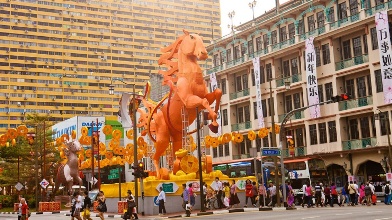Chinatown

Chinatown is a subzone and ethnic enclave located within the Outram district in the Central Area of Singapore . Featuring distinctly Chinese cultural elements, Chinatown has had a historically concentrated ethnic Chinese population.
As the largest ethnic group in Singapore is Chinese, Chinatown is considerably less of an enclave than it once was. However, the precinct does retain significant historical and cultural significance. Large sections of it have been declared national heritage sites officially designated for conservation by the Urban Redevelopment Authority.
Singapore’s Chinatown is known as Niu che shui ( in Chinese literally: “cow car water”) in Mandarin, Gu Chia Chwi in Hokkien and Ngau-che-shui in Cantonese – all of which mean “bullock water-cart” – and Kreta Ayer in Malay, which means “water cart”. This is due to the fact that Chinatown’s water supply was principally transported by animal-driven carts in the 19th century. It should be noted that while these names are sometimes used for referring to Chinatown in general, they actually refer to the area of Kreta Ayer Road.
The street architecture of town’s buildings, the shop houses especially, combine different elements of baroque architecture and Victorian architecture and do not have a single classification. Many of them were built in the style of painted ladies, and have been restored in that fashion. These styles result in a variety of different colours of which pastel is most dominant. Trengganu Street, Pagoda Street and Temple Street are such examples of this architecture, as well as development in Upper Cross Street and the houses in Club Street. Boat Quay was once a slave market along the Singapore River, Boat Quay has the most mixed-style shop houses on the island.
The architectural character of many of the terraces in Chinatown is much more Italianate in style than those of, for instance Emerald Hill or Petain Road. Windows often appear as mere slits with narrow timber jalousies (often with adjustable slats). Fanlights over the windows are usually quite decorative and the pilasters and balconies and even the plaster work and colours seem to be Mediterranean in flavour. The style was probably introduced by those early Chinese immigrants (both China-born and Straits-born) who had knowledge of the Portuguese architecture of Macau, Malacca and Goa. The Chettiars and Tamils from Southern India would also have been familiar with the European architecture there, although it is difficult to imagine how these people would have had a particularly strong influence on building in Chinatown.
Source : Wikipedia
https://www.youtube.com/watch?v=E81jBRKafTU
https://www.youtube.com/watch?v=EWdyfwKmVC0
https://www.youtube.com/watch?v=vecKtwN76t0
Reviews
Getting there : MRT Chinatown


Rate this article